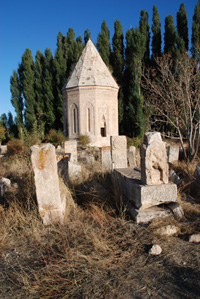Aghtamar Book Launched in Turkey
 27 October 2010
London (Gomidas Institute). Aghtamar: A Jewel of Medieval Armenian Architecture, a bilingual Turkish and English book, was launched in Van on September 17th and in Istanbul on September 21st.
27 October 2010
London (Gomidas Institute). Aghtamar: A Jewel of Medieval Armenian Architecture, a bilingual Turkish and English book, was launched in Van on September 17th and in Istanbul on September 21st.A co-publication between Gomidas Institute (London) and Birzamanlar Yayincilik (Istanbul), this work presented Turkish audiences with a fascinatinghistory of Aghtamar and its 10th century Church of the Holy Cross (Sourp Khach). The book was introduced by Ara Sarafian (Gomidas Institute) and Osman Koker (Birzamanlar Yayincilik).
Prior to his introduction, Sarafian thanked his hosts in Van and Istanbul, as well as a list of people and organisations who made the publication of Aghtamar: A Jewel of Medieval Armenian Architecture possible.
Sarafian and Koker noted that for all the recent discussions surrounding Aghtamar (both in Turkey and abroad) very little had been said about the actual monastic complex and the Church of the Holy Cross (Sourp Khach). The church deserved attention in its own right, as well as within its broader context of medieval Armenian architecture. One of the characteristics of Surp Khach was that it may have been more of a "royal" church than a "holy" one, as it primarily exalted the power of the Ardzruni dynasty of the Armenian Kingdom of Vasbouragan. This characteristic could be seen in the unique exterior carvings of the church, which mixed religious and secular themes (such as members of the Ardzruni dynasty). One good example is on the western facade of the church, where King Gagik and Jesus Christ faced each other, King Gagik was shown with greater stature and regal splendour than a simply clad Jesus Christ. The royal dimension of the church could also be seen elsewhere, including in the special elevated section (lodge) inside the church for the private meditation of the king. Sarafian also pointed out some of the art and symbolism on the church and added that they clearly reflected the influence of Vasburagan's Muslim Persian and Arab neighbours. There was even a classic image of a Seljuk archer on horseback on the eastern facade of the church. This was probably placed there during later restoration work. These peculiarities and eclectic characteristics were part of the rich history and beauty of the church.
Sarafian thanked Turkish authorities for restoring the Church of the Holy Cross which, sadly, remained something exceptional. Most Armenian antiquities in Turkey, some older than those on Aghtamar, have been destroyed and very few structures still remain standing. Sarafian ended his presentation with the hope that Turkish authorities would stop the destruction of the few remaining Armenian cultural treasures in Turkey today
« Back